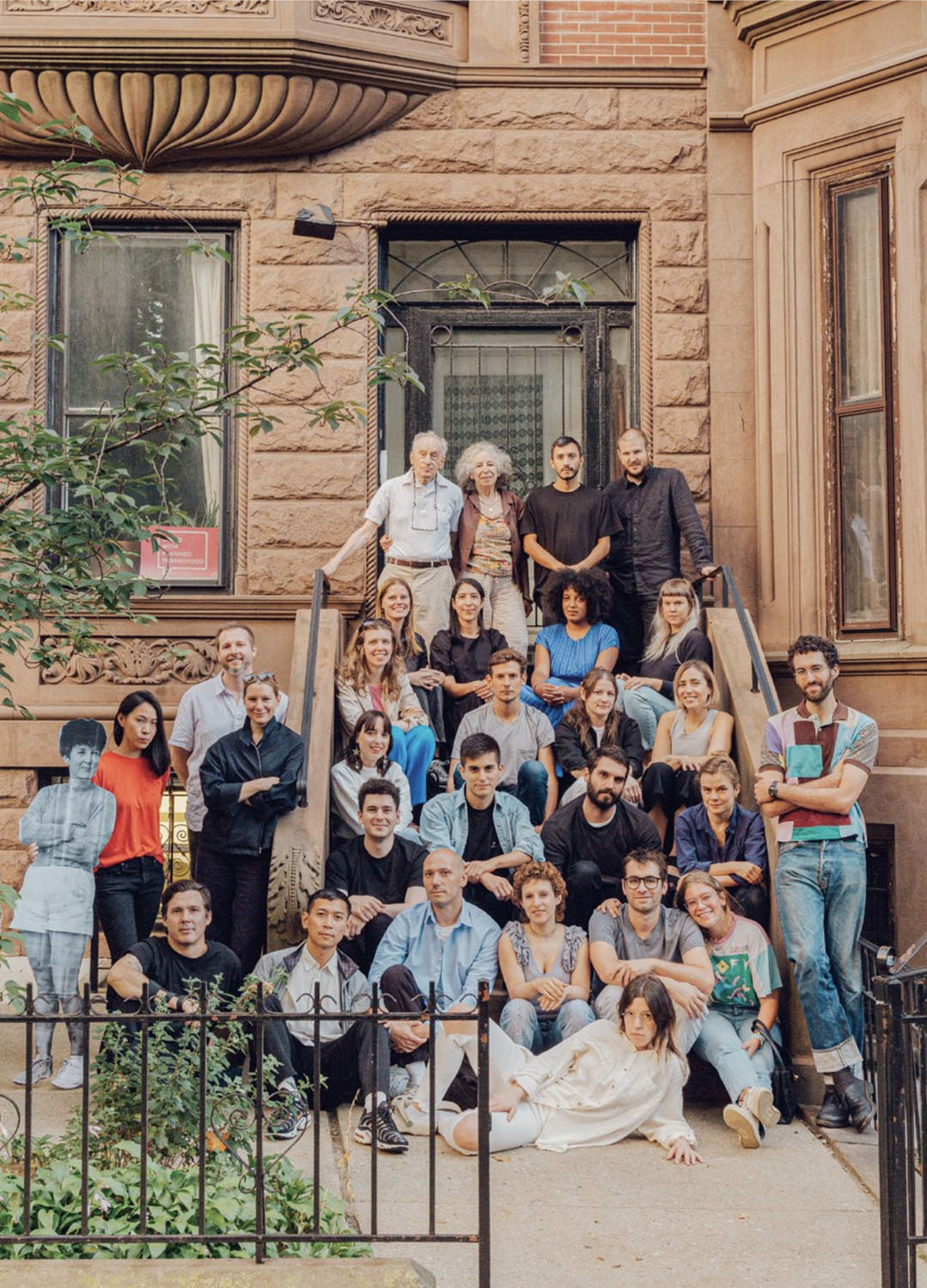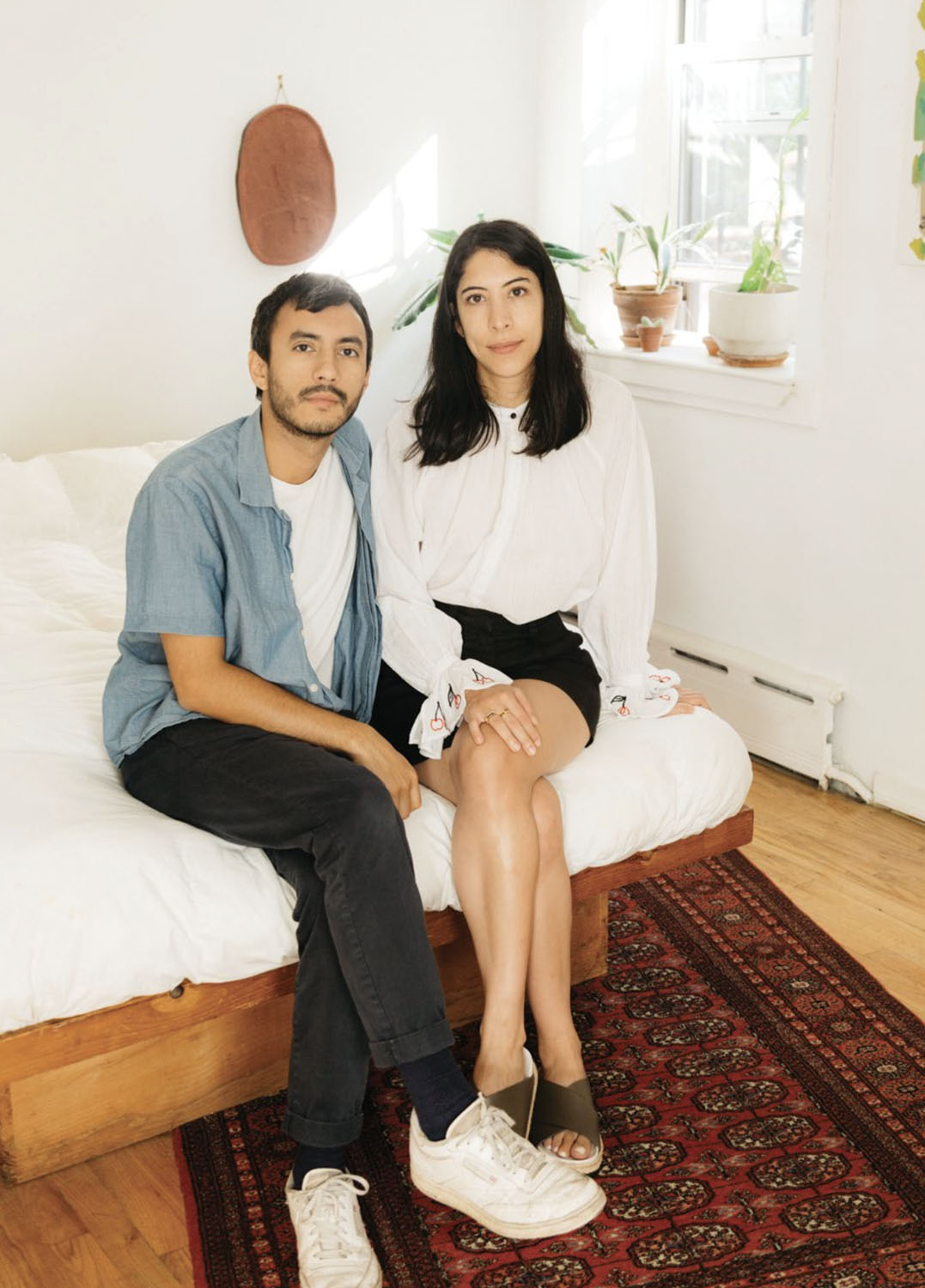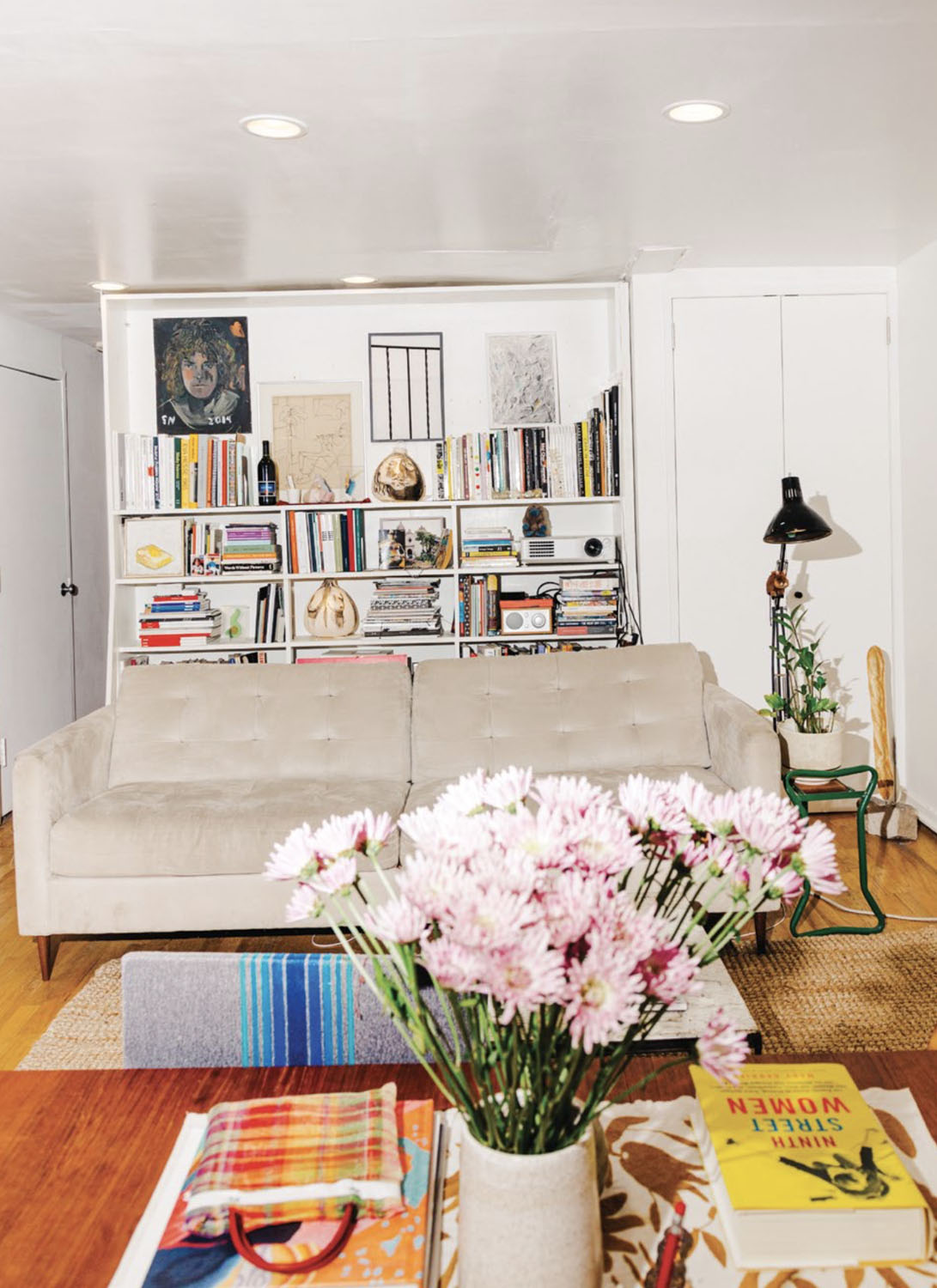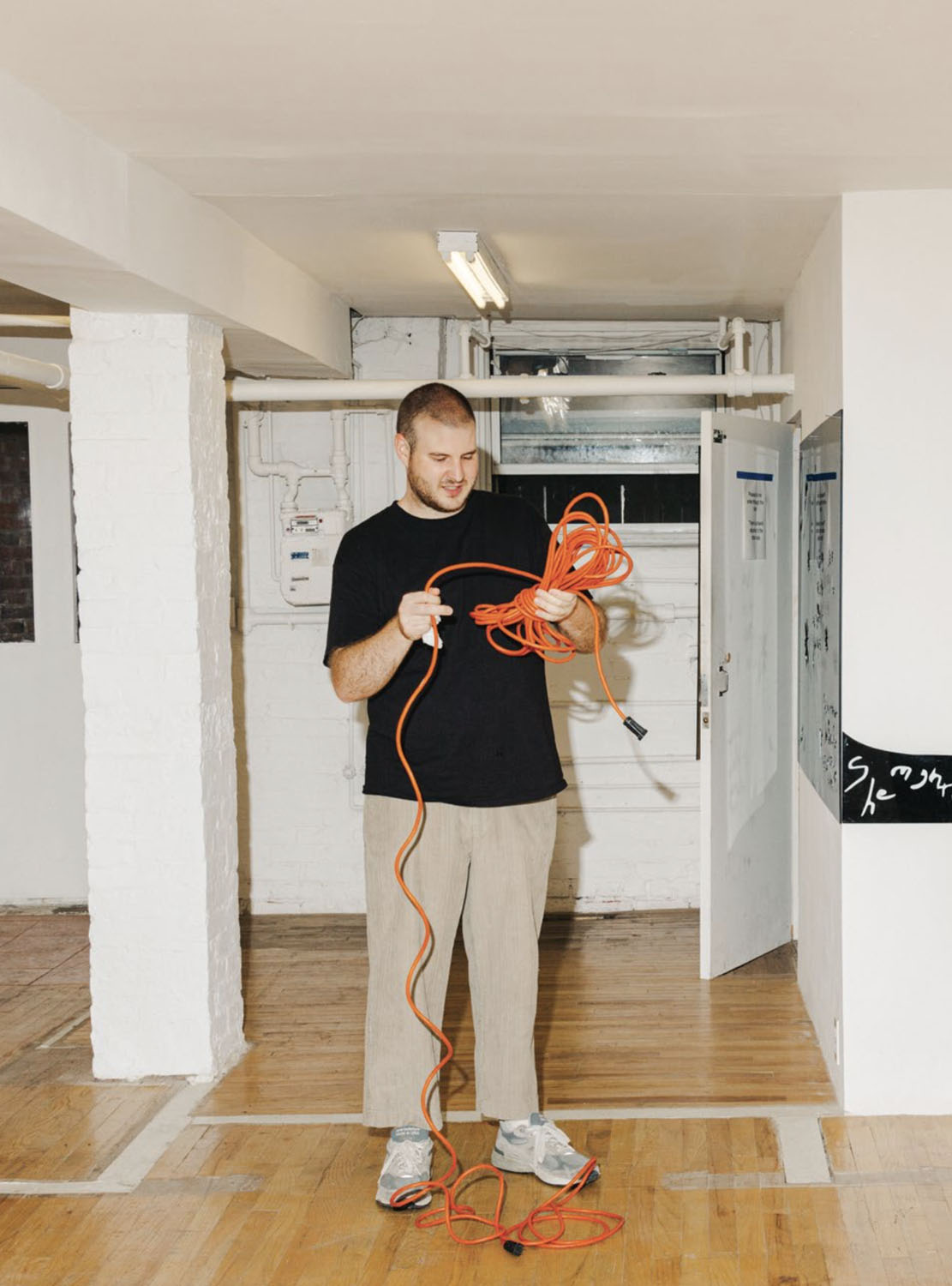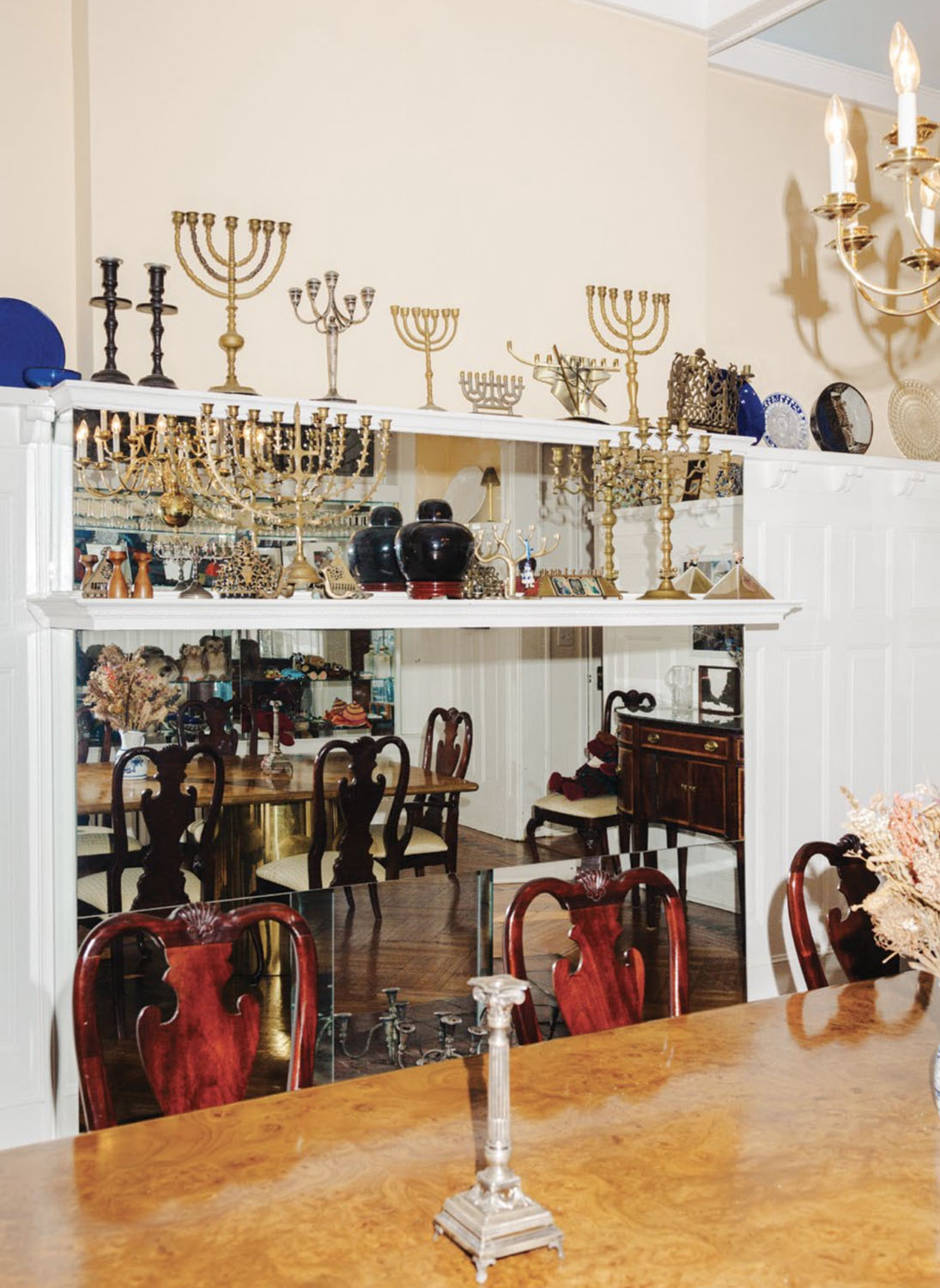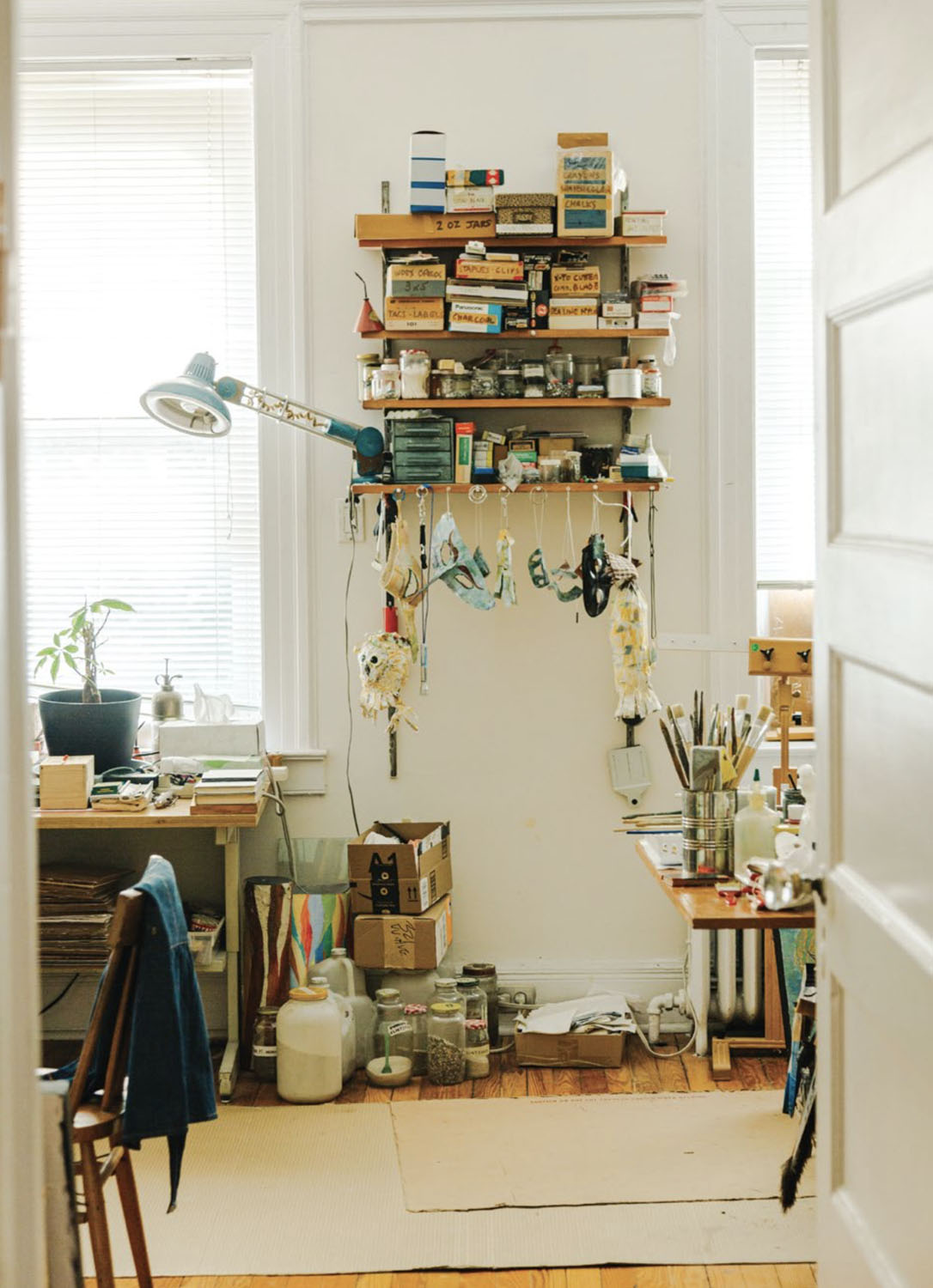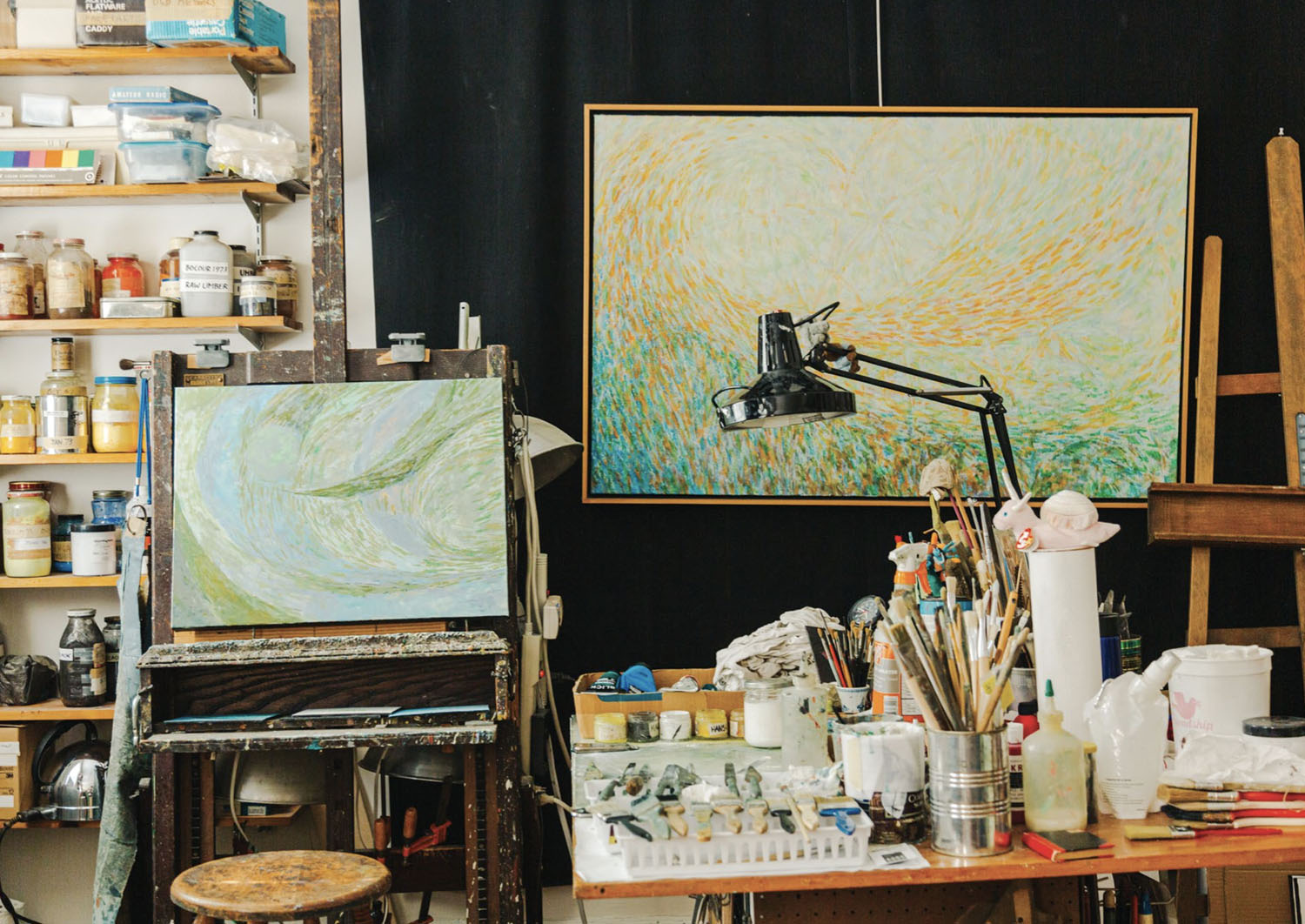321 GALLERY
Interviews by Michael Bullock
Photography by Daniel Terna
Apartamento 24, 2019
In New York City, artist-run galleries have historically played the role of giving alternative modes of cultural production the space to develop; International with Monument, American Fine Arts, Gavin Brown’s Enterprise, and Reena Spaulings were all founded by artists. These galleries have championed unique schools of thought pushing new, sometimes unconventional, ideas and aesthetics into a market-driven art world while becoming respected alternative institutions. In recent years, the stifling cost of real estate has driven this important experimental tradition towards extinction.
In 2012, the photographer Daniel Terna realised that the basement apartment he shares with his girlfriend, fellow gallerist Tara Ramadan, in his parents’ Brooklyn brownstone was big enough to accommodate both their living quarters and a significant exhibition space. Together with his business partners, fellow artist Tom Forkin and designer Tin Nguyen, he founded 321 Gallery. One mission of the space is to provide a platform for artists to present their NYC debut solo shows, including Elizabeth Conn-Hollyn, David Kirshoff, Sophy Naess, Rory Rosenberg, Am Schmidt, and Evan Whale. A second is to reintroduce artists with life-long careers whose work is perhaps more relevant today than it was when they originally made it. One example is the painter Fred Terna, Daniel’s father, a 95-year-old Holocaust survivor, whose studio is located just three floors above the gallery in the Clinton Hill home where he lives with Daniel’s mother, his wife, the obstetrician-gynaecologist Rebecca Shiffman.
The following three interviews illustrate the unlikely circumstances of how—under one roof, over two generations—the collective contributions of four artists, three gallerists, and one doctor have created one of the city’s most interesting new spaces to see art.
DANIEL TERNA & TARA RAMADAN
When, where, and how did you two meet?
Daniel: Like our love story?
Tara: We met in 2011. Stephanie Harris was our matchmaker. She told me, ‘Daniel’s not boyfriend material. He’s a little crazy, but you’ll have fun with him’.
Daniel: Stephanie was my roommate during undergrad at Bard, and Tara later went to grad school with her. I give her a lot of credit for introducing me to people who really opened up my world.
Tara: The night we met I was having dinner in Manhattan with my friends, and Stephanie texted Daniel and told him to join us. He was wearing a funky sweater and looked cute. We started talking and he immediately held my hand and that was that. He later told me that he thought I was an older Indian woman because the Indian restaurant we met at was so dimly lit.
Why did you grab her hand so quickly?
Daniel: At the time I worked the holiday markets selling jewellery for a designer in LA, and she insisted that sales were dependent on charming female tourists. When I was introduced to Tara I was already in a flirtatious mindset. So I instantly held her hand and told her what I knew about the ring she was wearing. We started dating after that. Tara: As soon as I finished grad school I moved in with Daniel and I never left. This is the first and only place I’ve ever lived in New York City.
And, Daniel, you had always lived here, except for college?
Daniel: After I graduated in 2009 I moved to Austin, Texas. The art scene was pretty small there, so I came back in 2010. I’ve lived here since then and I grew up upstairs. So I’ve pretty much been in this building my whole life.
What was this space when you were a kid?
Daniel: The basement was unfinished; it had this raggedy dirt floor and was filled with bugs. Nobody ever came down here. In 1996 we thought my grandma might move in, so my parents fixed it up, but that never ended up happening.
When did your parents buy this place?
Daniel: In 1983. When Clinton Hill was a very dangerous place.
That’s when the nickname of your main street, Myrtle Avenue, was Murder Avenue!
Daniel: Right. At that time cab drivers wouldn’t drive my parents home from Manhattan. The big condo across the street from here was a brothel/crack house. It was a whole different scene when I was growing up.
Your father is an older gentleman.
Daniel: He’s 95. My dad and mom are separated by 23 years. She’s 72. They adopted me in 1987.
You’re Colombian and your parents are Jewish. You’re a very strong example of nature versus nurture. Tara: You very much identify as Jewish. I guess the question is how much do you identify with being Colombian?
Daniel: I’m ethnically Colombian and culturally a New York Jew. That’s a very specific type of Jewish: a pseudo intellectual with all of the comedic anxieties. I went to Jewish day school from basically kindergarten until eighth grade. I learned Hebrew, I studied the Torah, I had a bar mitzvah. I had my bris in this house; my foreskin was cut off upstairs. We still have the table where a rabbi performed that procedure. During the ceremony I was blessed as a Jew. I would be offended if someone thought that just because my birth mother is Colombian, I wasn’t technically Jewish. It’s a very unique situation because I was raised in New York City not only by two Jewish parents, but my father is literally a concentration camp survivor, and my mom is the child of survivors. Jewish people refer to it as one G, two G, or three G. G being generation. I’m unusual because I’m both a 2G and a 3G.
That’s a tremendous amount of trauma to deal with.
Daniel: Exactly. Some of my own artwork explores inherited trauma.
And your father has also dealt with his history by making art.That must have had a big impact on you.
Daniel: He’s a painter, but I never wanted to be a painter, and as a kid I never quite understood his abstract paintings.
Tara: But still, you grew up in such a creative environment.
Daniel: I grew up in an environment where they encouraged reading books and valued being knowledgeable. They brought me to chamber music concerts. They believed TV was a distraction. In many ways they’re right, but they’re also very black and white about certain things. My dad is so old that jazz is the most alternative music he’ll listen to, but he prefers Bach and Stravinsky. He thinks if you listen to rock ‘n’ roll you’re an idiot.
Well, if you’re the son of a painter, pursuing art yourself is a much easier possibility than if you’re the son of a lawyer.
Tara: But he is also the son of a doctor. His mom’s an obstetrician-gynaecologist.
Did your parents battle for you to follow their lead?
Daniel: No, they just wanted me to figure it out for myself and believed that my strengths would flourish. My first interest was photojournalism. I thought of photography as a ‘truth-telling’ device. I originally planned to be a war correspondent, but I figured out I was really just an adrenaline junkie. That’s when I learned about fine art photography and realised that art could be a platform for issues that were more complex than presenting images from the front lines of a war.
Why did you decide to give up 70 percent of your apartment for a gallery?
Daniel: One night in 2012 we were sitting here having drinks with my friend Mekko Harjo, who I studied photography with. We were thinking, ‘We’re artists, but how do we get our work out there? We can’t just go to Chelsea and knock on doors’. Mekko said, ‘Your basement is so big, why don’t we just show our work right here?’ So we did. Our first show opened in the summer of 2012.That is before it officially became 321 Gallery, and your partnership with the artist Tom Forkin? Daniel: This was before I even met Tom. We just presented a two-person show of my and Meeko’s photography. We called it ‘Shadowline’. It was fun. It’s still on the 321 website.
Did you realise at the time that this was going to transform your apartment for the long term into a public space?
Daniel: It didn’t feel like that.
Tara: It doesn’t really even feel like that now, because we never used that space. And the gallery is open only one day a week. I enjoy having friends over, and it’s great to be able to support their work. It’s never felt like an inconvenience.
Tara, what role do you play in the gallery?
Tara: Tom and Daniel steer the ship. It’s their project. I’ve just benefited from proximity, though sometimes I get involved by editing their press releases or I might have suggestions on how to hang a show.
Daniel: There have been some nice moments when Tom and I have finished installing a show and Tara comes in with fresh eyes and asks, ‘What would it look like if you moved that piece there?’ And we try it out and it all clicks.
Tara, you work for Parker Gallery in Los Feliz, in LA; I never realised it before because neither of you conduct yourselves like the cliché, but technically you’re a gallerist couple?
Tara: I guess that’s true.
Daniel: I would never call myself a gallerist! Although gallerist is better than dealer.
I see you more like parents to a community.
Daniel: 321 is not big enough to be considered a community centre, but it’s become a clubhouse for a family of artists. In some respects, it becomes like a residency for the artist. What I enjoy is seeing a show evolve from the ground up: from the first studio visit until it’s hung, photographed, and the press release goes out. There are so many bumps in that journey, and sometimes ugly moments. The key is, once it’s hung, to look at the show with fresh eyes.
Tara: In my opinion some of the strongest galleries give artists opportunities to test their unresolved or experimental ideas. 321 has the mentality of being open and saying yes to noncommercial concepts. It’s a space were artists can be very comfortable and go as far as they need to go. We once hosted a five-weekend-long extremely elaborate performance piece by David Kirshoff. It involved multiple performers, a canoe filled with water, puppets, flowers, ceramics, video projections, cookie dough, and the cooking of eggs. It was pretty difficult to live with, because during the week the food rotted in the stagnant canoe water and it smelled horrible, but in retrospect it became one of our favourite pieces. Daniel: It is thus far the craziest, most miserable to live with, but one of the coolest shows we’ve ever done. David needed to do that show and we feel lucky to have hosted it.
What do your parents think of these wild, progressive, untraditional presentations?
Daniel: They seemed sceptical at first, but they are both supportive, as long as the house isn’t at risk. My dad has mentioned that this space reminds him of his childhood. He always talks about the culture of Kafka’s Prague. His father hosted guests in their home, musicians would casually come by and play, and intellectuals would have debates. After he attends our openings he often tells me that he admires the fact that we’ve created a place for people to gather to discuss and enjoy each other’s talent and ideas.
DANIEL TERNA & TOM FORKIN
When, where, and how did you two meet?
Daniel: For the second exhibit in my apartment I asked Tin Nguyen to show his work. While we conceived of the show, which also included work by Bryan Krueger, Tin felt it could use some sculpture and introduced me to Tom. One of Tom’s works was a 2D life-size, double-sided image of a baguette that spun vertically on top of a stone pedestal. I still have it in my living room.
Tom, how did you shift from showing in the space to becoming a partner in it? Tom: Tin and I were having the conversation young artists have about where we would want to show. We couldn’t think of any galleries that felt like a match. We wondered, ‘Who’s going to start that gallery?’ We realised we should! The next thought was, ‘Who do we know that has a space?’
Daniel: I had only organised two exhibits; it never occurred to me to run a galley long term.
Tom: After that show Tin and I approached Daniel and told him what we were thinking, and he was immediately interested. The next step was to make the front of his apartment look like a gallery.
Daniel: We ripped out parts of the ceiling and installed new lighting. We moved walls. The laundry room at the front of the space was originally double the size it is now. Which, at first, my parents weren’t so happy about.
Tom: That was a whole other conversation, negotiating with Daniel’s parents about tearing their space apart.
Daniel: We sat down with them. Tom and Tin didn’t know my parents at all at that point. We explained our vision. They weren’t really taking us seriously until we started demolition, and for the first year of shows they thought we were just throwing parties.
Tom: Until the Alyse Ronayne and Cait Carouge show was covered in the New York Times. Especially because the journalist, Will Heinrich, wrote about how their work referenced Judaism. That made it a double win for Daniel’s parents.
Daniel: They also didn’t really understand how contemporary galleries work.
Isn’t that strange, considering your father has been a painter almost his whole life? Daniel: Until I started this gallery, my dad rarely showed his work in this type of context. He was focused on his painting, but his first wife, Stella, was manicdepressive and bipolar. He was always home taking care of her, so he wasn’t hanging out with the artists downtown or going to parties at Warhol’s Factory. He painted, and a gallery/frame shop on the Upper East Side sold his canvases to clients in the area, such as doctor’s offices.
And now you show his work? Which brings the whole story full circle. Tom: It’s true. The first time we showed his work was also our first art fair in New York, the New Art Dealers Alliance, which was funny because we were applying as a first- time gallery and our proposal was to show a painter in his 90s who survived the Holocaust. We thought he would be best because the majority of artists in that fair are young and their worldview and aesthetics can be pretty similar. Fred’s images work with many early 20th-century forms. There are expressionist, constructivist, and futurist motifs—also a lot of texture, reminiscent of early cubist paintings. He’s very aware of all those references, but he comes at it with his own personal experience, the deep trauma of surviving concentration camps, which makes it totally unique.
Daniel: Among the artists we’ve shown, there’s a great admiration for my dad and his work. Artists that meet Fred are inspired by his dedication to his practice. It’s beautiful to think about making paintings in your 90s. The world we live in operates on such short-term gains. My dad paints every day and has been for 70 years. That puts everything in perspective.
What’s 321’s mission statement?
Tom: It’s artist-centric. It provides a space where artists can feel comfortable showing their work. Daniel: Since it’s artist-run, we aim to always put the artist’s needs first. It’s about support and collaboration and the opportunity to ex- hibit for artists that haven’t had that opportunity. It’s a place for them to make use of the space and not have the burden or concerns that they would encounter at a gallery with more overheads. Is it possible your lack of knowledge gave you courage? Daniel: Maybe. I was never stifled by the weight of traditions. I was just down to collaborate with artists whose perspectives were totally different than mine.
How do you decide on the programming?
Tom: We mostly work with people within our community. We meet artists through other artists. If we get along with them and they’re into what we’re doing, then we approach them about working together. It’s pretty casual. We don’t have the financial pressure to open a new painting show every month. Actually, except for Fred, we don’t really ever show paintings. Not that I don’t enjoy them, but there are so many venues that almost exclusively show painting.
Daniel: When we started, we tried to do a show every month. That was stressful. Tom was finishing grad school and I was just starting. There were many differing opinions and perspectives among the three of us on how to do things.
Tom: Tin eventually resigned. He became more interested in the intersection between art and fashion and left to focus on his clothing label, CFGNY. We all remain close friends.Is there a philosophy that you share, or a type of work that you both admire? What conceptually holds the program together?
Tom: It’s not about aesthetics or medium specificity; for me, it’s about an artist’s attitude or approach. It’s also about how we get along with the artist, because every show is collaborative on some level.
Daniel: I’ve learned a lot from Tom. At the beginning my mentality was much more conservative, but Tom has always been focused on alternative or unconventional work and inventive strategies for presentation.
Tom: I’m attracted to an artist’s thought process, people who have a really unique perspective, like Am Schmidt. Her first show with us, ‘Fierce (Untitled)’ (2014), documented a performance piece in which she wore only Abercrombie & Fitch’s graphic T-shirts and their Fierce perfume every day for one year. She’s the only artist that’s ever had two solo shows here, which says how much we believe in her work. Although we don’t officially represent anyone, there are certain artists that we continue to work closely with, such as Paul McMahon, Paul Kopkau, Evan Whale, Raque Ford, and Am Schmidt. It’s more of an open relationship than the traditional representational model.
Paul McMahon’s show is interesting because he’s also not from your generation. He recently turned 70 and yet you sincerely identify with him. He’s an artist that was never re- warded with commercial success. Your show can be credited with bringing him back into the contemporary art dialogue.
Daniel: For me, his work is a great example of a Pictures Generation artist. He’s friends with a lot of artists we admire: Dan Graham, Mike Smith, James Welling, Matt Mullican, and Cindy Sherman. He also ran a project space in Boston in the ‘70s that was very similar to 321. So there was an instant connection.
Tom: The way he was combining images and text in the ‘70s and ‘80s is much closer to the way image culture exists now, in terms of the internet. Paul was writing on postcards; he took images and changed their context by adding text to them. He was creating the first analogue memes, in a way. When we went to his studio in Woodstock and saw his life’s work, it was challenging. How do you show over 40 years’ worth of work?
Daniel: We decided to present a mini retrospective titled ‘44’, which included 44 works from 44 years. Paul chose 44 because he’s into numerology and it just happened that Obama was the 44th president.
What did he think of being presented by a new generation?
Daniel: He was really appreciative. It allowed him to reconnect with the New York art world. Linda Montano came to do a performance with him. Martha Wilson, Louise Lawler, Mike Smith, Dan Graham—all artist we deeply respect— came to his show and hung out in our kitchen. Tom: We also sold his work. He said we were the first gallery to ever sell anything; he was appreciative of that.
Daniel: Plus his show received our first review in Artforum. Sounds like it was a win-win for everybody.
It seems your gallery roster is made up of older men and younger women?
Daniel: Now that you say it, it does have an unintentional old-young dynamic. Tom: But it’s not split along gender lines; our current exhibit, ‘Crude Suite’, a sculpture show that questions value and aspiration within our patriarchal commodity culture, is by our peer Paul Kopkau. But since we started, we have always equally collaborated with male and female artists of all ages.
REBECCA SHIFFMAN & FRED TERNA
When, where, and how did you two meet?
Rebecca: Fred picked me up at the 51st Street subway station in New York City in 1982. Fred: That night I had read a poem at a meeting of Holocaust survivors. Afterwards I felt miserable. In the subway station there was a young lady I remembered seeing at the meet- ing. I brashly asked her, ‘Do you feel like having a cup of coffee? I need to talk to somebody’.
Rebecca: He told me he was a starving artist, but it wasn’t entirely true. After we married he bought this house for us. At the time I only had student debts, because I was in grad school to become a foetal medicine specialist.
Fred: We’ve lived here for 37 years. It was built around 1880, and at the time this area was very fashionable. Rebecca: In that period they called this street Doctor’s Row, but when we bought it the neighbourhood had fallen on hard times. Fred: This house is exceptional in the sense that the layout is different than typical brownstones. Usually you enter these buildings into a staircase, but because this building has central stairs it was saved from being subdivided.
Rebecca: The people that sold us the house, I don’t know why they chose to live in a brownstone because they covered up many of the traditional features. They mirrored the dining room fireplace. They also covered the ceiling in the second storey bathroom with disco ballstyle wallpaper. Although, that was Daniel’s favourite room as a kid. A doctor and an artist is a rare combination. How does that work? Rebecca: I would die of boredom if I were living with another doctor. It’s a pleasure to live with Fred’s art and creative process. But Fred also has the personality of an accountant. He’s very methodical. I’m glad that one of us is. I’m big picture and he’s detail oriented.
Fred: I would’ve made a good bookkeeper. Because I use so many different supplies, I need an organised system to keep track of everything. If an item isn’t where it’s supposed to be, it’s lost forever. When I can’t find something, Rebecca is my memory.
Rebecca: You know how couples become.
Daniel told me you grew up in South America?
Rebecca: Yes, in Colombia. My parents were Holocaust survivors and my father’s sister had left Europe for Colombia before the war started, so that’s how we ended up there. And coincidentally Daniel’s birth mother is Colombian, part of the reason she was comfortable with us adopting him was because she knew I grew up there.
How did you find her?
Rebecca: A colleague of mine met her at the hospital that he worked at. She told him that she had to give up her baby. He knew we was a Colombian kid growing up in a strong Jewish culture in New York City. Rebecca: Well, to be Jewish and Colombian is not entirely mutually exclusive. There’s a Sephardic community in Colombia that came as a result of the Inquisition and has been there since the 1600s. There is a later Ashkenazi community, some which escaped Europe before 1939 and some, like my family, that came after World War II. All of South America had Jewish populations; actually, the early American Jewish community came from Brazil. Once the Inquisition reached Brazil, they moved to America.
Fred, when did you move to New York?
Fred: After I was released from a concentration camp, I was in bad shape. I was shipped to Prague, where I was hospitalised. In 1946 I married my first wife, Stella. Together we im- migrated to Paris with false papers. Then in 1952, when I was about 29, Stella and I left for New York. She was a wonderful person, but the Holocaust left her emotionally distraught. Today we have a term for that: posttraumatic stress. It made her suicidal. She needed constant supervision, so I stayed home with her. What can you do for a living if you can’t leave your apartment? So I became a painter. It’s as simple as that.
How long were you imprisoned?
Fred: Three years, six months, three weeks, and two days. Ever since I was released I’ve been involved in speaking about the history of the Holocaust. I’m officially still part of the Speakers Bureau of the Museum of Jewish Heritage.
It’s incredible that you’re able to share your firsthand account of that horrific experience.
Fred: I know how lucky I am. I’m lucky to have met Rebecca. Rebecca, my involvement with Holocaust survivors, and my art really keep me moving. As you can see, my paintings have taken over our entire home. There is work from every era of my life. Therefore, I’m surrounded by many distant feelings. I return to a few different themes, but the Holocaust is always a big part of it. Daniel has plans to put some of these paintings in better order. Physically, I can’t handle moving canvas anymore.
What is it like to have your son become your gallerist?
Fred: I’m a reasonably good painter, but I never linked up with the right promoter. Painting: anybody can do it. Selling: now that’s an art I have never been successful at. I’m fortunate Daniel started working on that.
What was your first reaction when he told you he wanted to transform your basement into a place to present artwork?
Fred: That it’s his apartment and he should do what he wants with it.
Rebecca: My first concern about the gallery was about the legalities. When Daniel started, he didn’t have insurance in case somebody got injured. Although now I admire that he’s really taken it on. He’s serious about it, and it’s been well received. You’re here because of that; more power to him.
Fred: I think the way Daniel and Tom handle the gallery is imaginative. They show artists who are unusual, people who have developed their own unique language. They provide an important platform for new and different ideas to be seen. The question all artists share is: how to become visible? From my view, three generations away, the gallery seems to be very much a part of its time.
Rebecca: Each opening attracts about 150 guests. All kinds of people attend, younger and older, some are friends of the artists, some are neighbours passing by. It’s wonderful for the artists, and I don’t know what the finances are, but I think they actually make some money. He’s also very protective of Fred’s work.
Fred: Daniel decides on the piece, prices, and promotion. All I do is I paint. I leave for him a repository of the ideas of a person who’s painted for 70 years as a survivor of the Holocaust. To me, painting is selfindulgent, but it’s also cathartic. It has a historical value and a potential value for an audience that is willing to read the paintings through that context; although now, it’s not for me to explain. Daniel has to figure out the right way to talk about it. I’ve done my job making the paintings. What happens afterwards is his job.
Rebecca: This may sound crazy, but to me it echoes a part of Cabalistic theory, the idea that God originally occupied all space and he chose to shrink himself in order to make room for the world. In this case, Daniel shrunk his living quarters to make room for other artists. I think that’s beautiful.
Fred: He’s working on something unusual. His gallery is like a newborn baby. Who knows how it will grow. Many artists that became household names started out in odd, underappreciated places and then somehow caught the imagination of the world. Van Gogh, for instance, only sold one painting during his entire life.
Rebecca: Parents always worry if their kids are doing alright. We’re lucky: with the gallery downstairs, we get to see that he does alright. But more than anything, what I really appreciate about Daniel is that he’s turned out to be a really decent person. When he was growing up the main thing that I wanted for him was to embody the word ‘mensch’, and I think he does.
